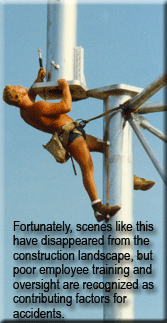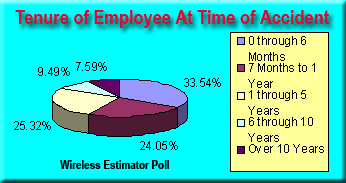|
Highest likelihood of an accident is found to be during the employee's first 30 days
April 11, 2005 -- Statistics indicate that more than half of all tower-related construction accidents occur to employees with less than one year with their company. According to a recent poll conducted on WirelessEstimator.com, 58% of 158 respondents last month said that their company's last accident involved an employee with tenure of one year or less. 158 respondents last month said that their company's last accident involved an employee with tenure of one year or less.
"That high percentage is not surprising and is certainly reflective of what we have been identifying," said Patrick Shea of Arthur J. Gallagher who tracks accidents and loss payments for the tower construction industry. "Our data in 2004 indicates that approximately 62% of our incurred losses were for employees with less than 12 months tenure," Shea said, identifying that the largest loss, 33% of all incurred payments, came from employees that had been employed less than three months. Shea manages the National Association of Tower Erector's insurance program that is underwritten by AIG.
Of more than 500 accidents reviewed, Shea said, 42% were in workers compensation category 5040 for those employees involved in steel erection. Tower maintenance as well as radio equipment installation were 9% each with steel fabrication at 8%. Painting was identified as providing 4% of the total. The lowest construction craft was telephone system installation at 2%. Fourty-one percent of all losses occurred between 8 a.m. and noon.
Texas leads country in accidents
According to Shea, of the top ten states, the most accidents last year occurred in Texas followed by Oklahoma, Florida, Michigan, North Carolina, Illinois, Iowa, Georgia, Maryland and Louisiana. He pointed out that tower companies operate in multiple states and that these rankings do not necessarily indicate that employees in one state are more careless than in another. In addition, the amount of construction being conducted within that state will also affect the number of accidents.
The WirelessEstimator.com poll identified employees with over 10 years tenure were less likely to have an accident of any kind and only represented 8% of the total. Shea sets the figure at approximately 4%. Those workers with 1-5 years of tenure accounted for 25% and 6-10 years, 10%.
Economics tagged by some employers for inadequate training
Of those tower construction workers employed less than three months, the greatest percentage of injury accidents occur within the first 30 days, says Terry Keller, CEO of TCB Group, Inc., a safety consultancy and training company. "The reason for that is there is oftentimes inadequate training provided by the employer," he said.
Keller joins other industry observers who believe that proper training isn't provided in many companies when the employee is first hired. Contractors are putting inexperienced people to work quickly to man-load their projects, he said. "Typically, they will not provide the required training until the employee has passed the three-month probationary period. Sadly, some companies acknowledge that they know they need to have the training, but it all comes down to the economics," Keller explained.
Proper training and supervision may be lacking
Bill Vance, President of CITCA, a communications industry training and certification academy, agrees that employer training is lacking during the initial days of a worker's employment, sending them in the field with little exposure to what they'll be doing and  without the corresponding safety procedures required to fulfill their tasks. without the corresponding safety procedures required to fulfill their tasks.
In addition, Vance, a former director of the National Association of Tower Erectors, says the problem is compounded by "companies that do not carefully check credentials or experience levels" and take the new employer's information at face level. He also said that accident rates are higher during the first 30 days because some foremen and leadmen have so much going on with their project that they are not taking the time to properly work with new employees to ensure that they are receiving the proper on site training and supervision.
Pool size questioned for accurate analysis
Although he sees value in these statistics, Winton Wilcox, Jr., President of ComTrain L.L.C., a company that provides safety certification programs, believes that the industry would be better served if more data were available from other companies in the communications industry.
"The problem nowadays is accelerated as we try to decide what the industry is. Sometimes empirical data is drawn out of a bad pool, a pool that is more volatile," Wilcox said. He considers antenna and line installation work and tower erection to be much more visible, but it should be included under a larger umbrella of communications workers who do similar tasks. Wilcox also says that the accident statistics drawn from a smaller group of contractors might not represent the industry at large.
"They may not be valid. There is a much broader group of communications workers that climb towers," Wilcox said, identifying utility workers and railroads, citing Union Pacific which has thousands of towers throughout the country that are erected and maintained by their employees.
Wilcox says that quantifiable data is hidden within the numerous state and federal reporting agencies. He also thinks that accident data should be compared to the tenure of the company as well. 
Copyright © Wireless Estimator, Inc. Please request reprint permission.
|